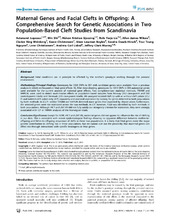Maternal genes and facial clefts in offspring: a comprehensive search for genetic associations in two population-based cleft studies from Scandinavia
Jugessur, Astanand; Shi, Min; Gjessing, Håkon K.; Lie, Rolv Terje; Wilcox, Allen James; Weinberg, Clarice Ring; Christensen, Kaare; Boyles, Abee Lowman; Daack-Hirsch, Sandra; Nguyen, Truc Trung; Christiansen, Lene; Lidral, Andrew Carl; Murray, Jeffrey Clark
Peer reviewed, Journal article
Published version
Permanent lenke
https://hdl.handle.net/1956/4340Utgivelsesdato
2010-07-09Metadata
Vis full innførselSamlinger
Originalversjon
https://doi.org/10.1371/journal.pone.0011493Sammendrag
Background Fetal conditions can in principle be affected by the mother's genotype working through the prenatal environment. Methodology/Principal Findings Genotypes for 1536 SNPs in 357 cleft candidate genes were available from a previous analysis in which we focused on fetal gene effects [1]. After data-cleaning, genotypes for 1315 SNPs in 334 autosomal genes were available for the current analysis of maternal gene effects. Two complementary statistical methods, TRIMM and HAPLIN, were used to detect multi-marker effects in population-based samples from Norway (562 case-parent and 592 control-parent triads) and Denmark (235 case-parent triads). We analyzed isolated cleft lip with or without cleft palate (iCL/P) and isolated cleft palate only (iCP) separately and assessed replication by looking for genes detected in both populations by both methods. In iCL/P, neither TRIMM nor HAPLIN detected more genes than expected by chance alone; furthermore, the selected genes were not replicated across the two methods. In iCP, however, FLNB was identified by both methods in both populations. Although HIC1 and ZNF189 did not fully satisfy our stringency criterion for replication, they were strongly associated with iCP in TRIMM analyses of the Norwegian triads. Conclusion/Significance Except for FLNB, HIC1 and ZNF189, maternal genes did not appear to influence the risk of clefting in our data. This is consistent with recent epidemiological findings showing no apparent difference between mother-to-offspring and father-to-offspring recurrence of clefts in these two populations. It is likely that fetal genes make the major genetic contribution to clefting risk in these populations, but we cannot rule out the possibility that maternal genes can affect risk through interactions with specific teratogens or fetal genes.
Utgiver
Public Library of ScienceOpphavsrett
Copyright 2010 Jugessur et al.Jugessur et al.

